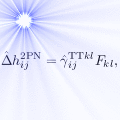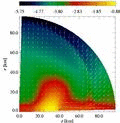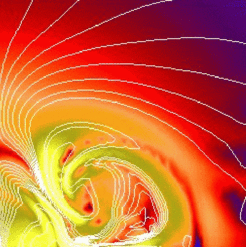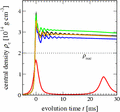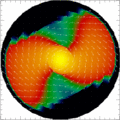Relativistic Hydrodynamics & Numerical Relativity
If the typical velocity in an astrophysical system is small and gravity is weak, it is sufficient to use the Newtonian approximation of the laws of motion and gravity to model such a system. However, these approximations do not always hold.
Supermassive black holes in quasars and solar-mass-sized black holes with accretion discs power jets made of particles which move at velocities close to the speed of light. Here, special relativistic hydrodynamics is needed for numerical simulations. Our group has developed and successfully applied computer codes for such simulations for many years.
To describe compact objects one must resort to general relativity, a generalization of Newton's theory of gravity. Such a situation is encountered near black holes (the prospective driving engines of astrophysical jets), during the formation of a neutron star or a black hole in a core collapse supernova, in collapsars (one possible source of gamma-ray bursts), or during the merger of two neutron stars. (another possible source of gamma-ray bursts).
Some of these sources are thought to emit detectable amounts of gravitational radiation. While light or sound waves propagate through spacetime, gravitational waves are ripples of spacetime itself. Such spacetime distortions have been predicted by Einstein in his General Theory of Relativity hundred years ago. They are planned to be measured soon by laser interferometers (GEO 600, LIGO, VIRGO).
In order to accomplish a successful detection of gravitational waves, very efficient electronic filters have to be employed to extract a possible signal from the very noisy detector data. It is therefore of great importance to predict as precise as possible the signals from theoretical models of various astrophysical sources of gravitational radiation. As part of the German research network SFB Transregio 7 "Gravitational Wave Astronomy", our group has taken part in this international interdisciplinary scientific effort.
Further Information:
Below we provide further information about our projects to develop numerical codes for simulations of both special and general relativistic hydrodynamics, and for applications involving dynamical spacetimes.
A simulation tool that resulted from our efforts is CoCONuT, a general relativistic hydrodynamics code with approximate dynamical space-time evolution
As a service to the scientific community, we also provide a catalog of gravitational waveforms of general relativistic numerical simulations of rotational core collapse and a literature catalog of publications about gravitational wave from core collapse supernovae.




